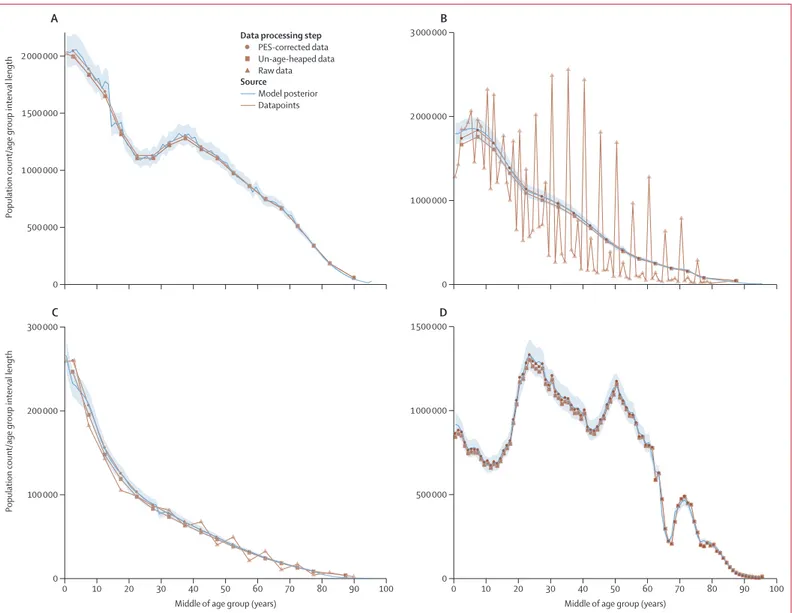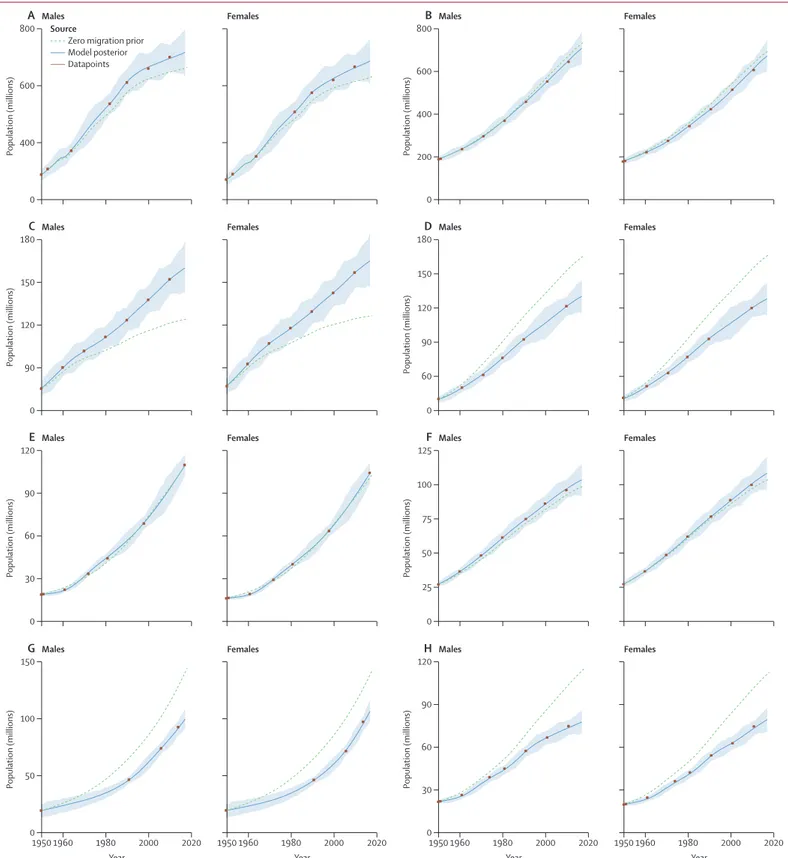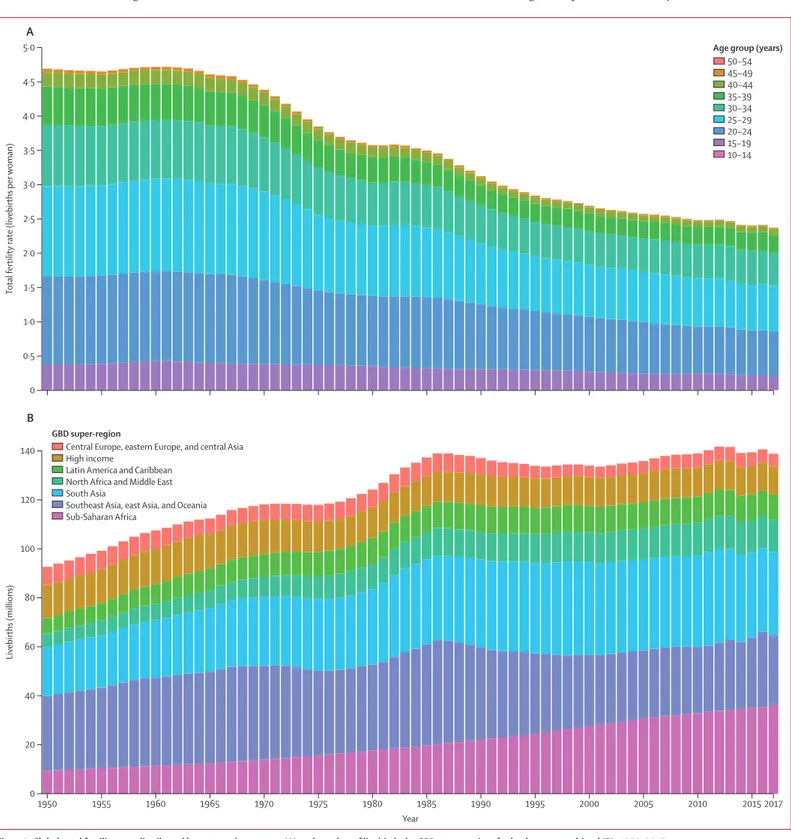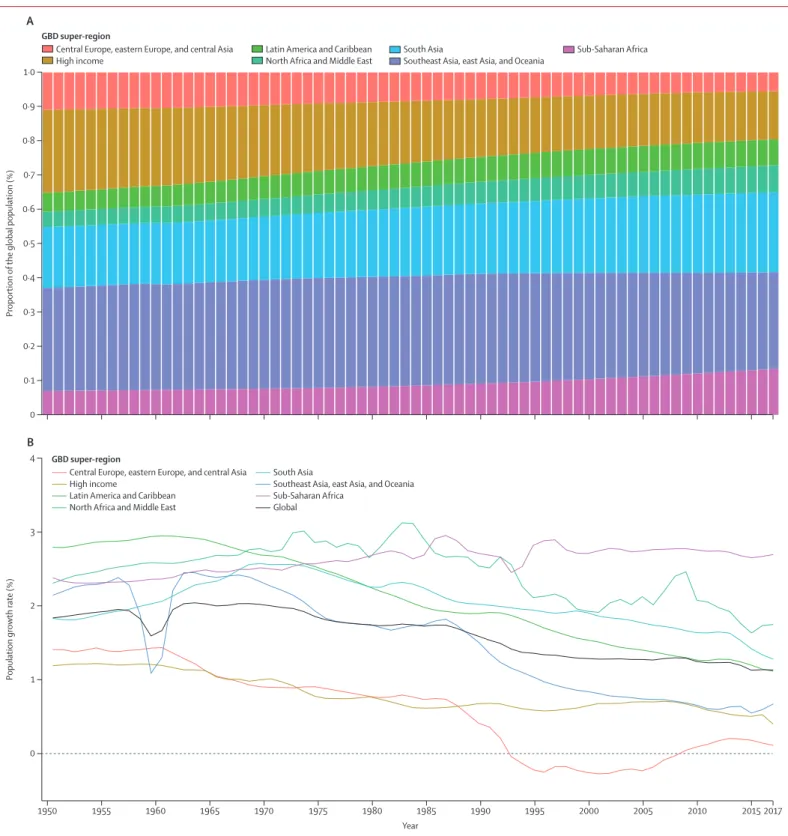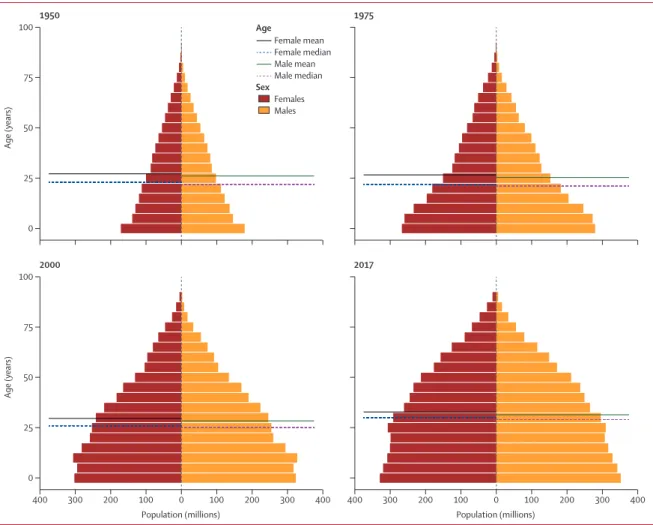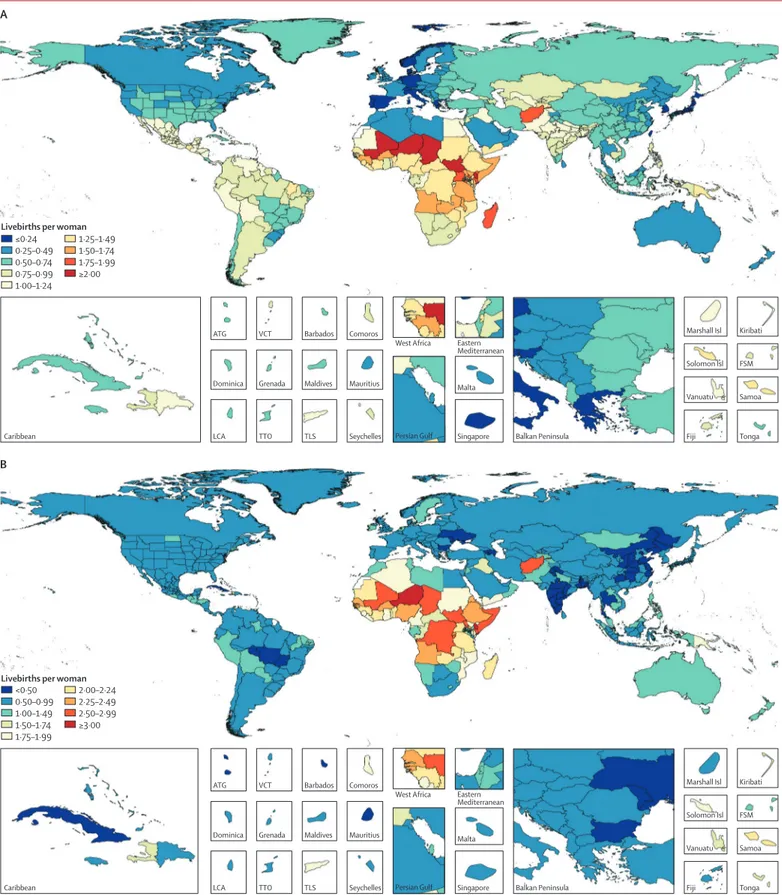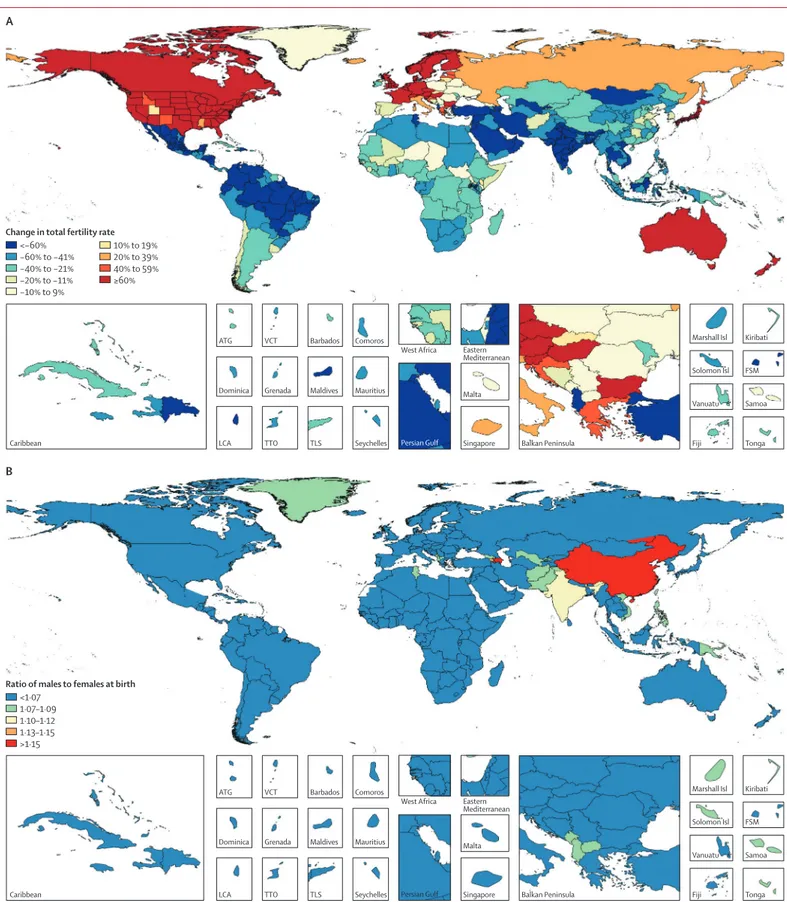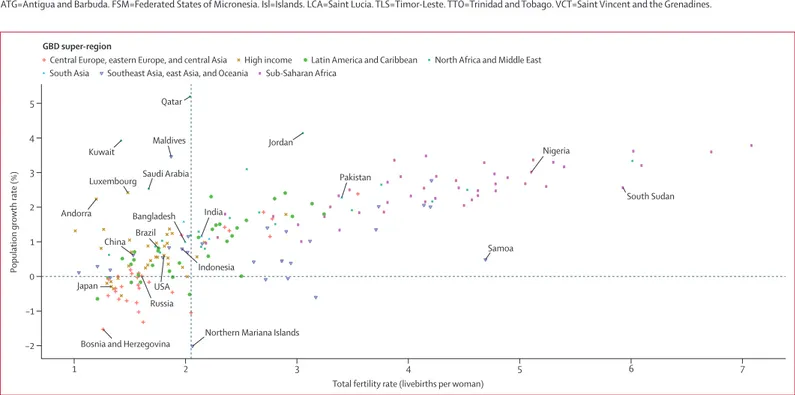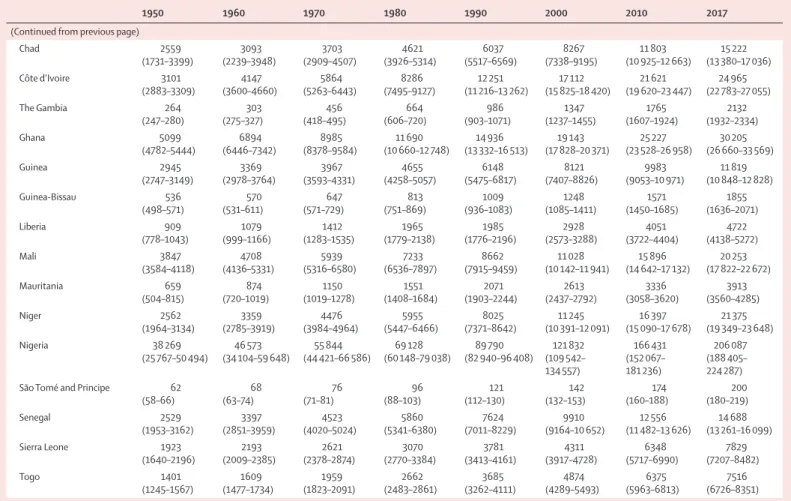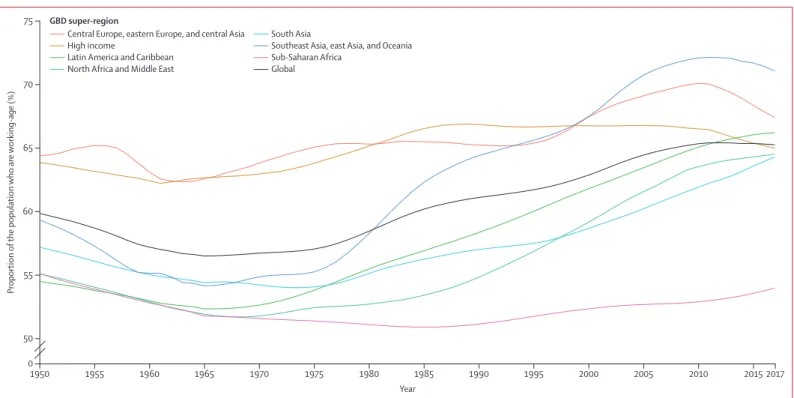This is the published version of a paper published in The Lancet.
Citation for the original published paper (version of record):
Murray, C J., Callender, C., Kulikoff, X R., Srinivasan, V., Abate, D. et al. (2018)
Population and fertility by age and sex for 195 countries and territories, 1950-2017: a
systematic analysis for the Global Burden of Disease Study 2017
The Lancet, 392(10159): 51-2015
https://doi.org/10.1016/S0140-6736(18)32278-5
Access to the published version may require subscription.
N.B. When citing this work, cite the original published paper.
Permanent link to this version:
Population and fertility by age and sex for 195 countries and
territories, 1950–2017: a systematic analysis for the Global
Burden of Disease Study 2017
GBD 2017 Population and Fertility Collaborators*
Summary
Background
Population estimates underpin demographic and epidemiological research and are used to track progress
on numerous international indicators of health and development. To date, internationally available estimates of
population and fertility, although useful, have not been produced with transparent and replicable methods and do not
use standardised estimates of mortality. We present single-calendar year and single-year of age estimates of fertility
and population by sex with standardised and replicable methods.
Methods
We estimated population in 195 locations by single year of age and single calendar year from 1950 to 2017
with standardised and replicable methods. We based the estimates on the demographic balancing equation, with
inputs of fertility, mortality, population, and migration data. Fertility data came from 7817 location-years of vital
registration data, 429 surveys reporting complete birth histories, and 977 surveys and censuses reporting summary
birth histories. We estimated age-specific fertility rates (ASFRs; the annual number of livebirths to women of a
specified age group per 1000 women in that age group) by use of spatiotemporal Gaussian process regression and used
the ASFRs to estimate total fertility rates (TFRs; the average number of children a woman would bear if she survived
through the end of the reproductive age span [age 10–54 years] and experienced at each age a particular set of ASFRs
observed in the year of interest). Because of sparse data, fertility at ages 10–14 years and 50–54 years was estimated
from data on fertility in women aged 15–19 years and 45–49 years, through use of linear regression. Age-specific
mortality data came from the Global Burden of Diseases, Injuries, and Risk Factors Study (GBD) 2017 estimates. Data
on population came from 1257 censuses and 761 population registry location-years and were adjusted for
underenumeration and age misreporting with standard demographic methods. Migration was estimated with the
GBD Bayesian demographic balancing model, after incorporating information about refugee migration into the model
prior. Final population estimates used the cohort-component method of population projection, with inputs of fertility,
mortality, and migration data. Population uncertainty was estimated by use of out-of-sample predictive validity testing.
With these data, we estimated the trends in population by age and sex and in fertility by age between 1950 and 2017 in
195 countries and territories.
Findings
From 1950 to 2017, TFRs decreased by 49·4% (95% uncertainty interval [UI] 46·4–52·0). The TFR decreased
from 4·7 livebirths (4·5–4·9) to 2·4 livebirths (2·2–2·5), and the ASFR of mothers aged 10–19 years decreased from
37 livebirths (34–40) to 22 livebirths (19–24) per 1000 women. Despite reductions in the TFR, the global population
has been increasing by an average of 83·8 million people per year since 1985. The global population increased by
197·2% (193·3–200·8) since 1950, from 2·6 billion (2·5–2·6) to 7·6 billion (7·4–7·9) people in 2017; much of this
increase was in the proportion of the global population in south Asia and sub-Saharan Africa. The global annual rate
of population growth increased between 1950 and 1964, when it peaked at 2·0%; this rate then remained nearly
constant until 1970 and then decreased to 1·1% in 2017. Population growth rates in the southeast Asia, east Asia, and
Oceania GBD super-region decreased from 2·5% in 1963 to 0·7% in 2017, whereas in sub-Saharan Africa, population
growth rates were almost at the highest reported levels ever in 2017, when they were at 2·7%. The global average age
increased from 26·6 years in 1950 to 32·1 years in 2017, and the proportion of the population that is of working age
(age 15–64 years) increased from 59·9% to 65·3%. At the national level, the TFR decreased in all countries and
territories between 1950 and 2017; in 2017, TFRs ranged from a low of 1·0 livebirths (95% UI 0·9–1·2) in Cyprus to a
high of 7·1 livebirths (6·8–7·4) in Niger. The TFR under age 25 years (TFU25; number of livebirths expected by age
25 years for a hypothetical woman who survived the age group and was exposed to current ASFRs) in 2017 ranged
from 0·08 livebirths (0·07–0·09) in South Korea to 2·4 livebirths (2·2–2·6) in Niger, and the TFR over age 30 years
(TFO30; number of livebirths expected for a hypothetical woman ageing from 30 to 54 years who survived the age
group and was exposed to current ASFRs) ranged from a low of 0·3 livebirths (0·3–0·4) in Puerto Rico to a high of
3·1 livebirths (3·0–3·2) in Niger. TFO30 was higher than TFU25 in 145 countries and territories in 2017. 33 countries
had a negative population growth rate from 2010 to 2017, most of which were located in central, eastern, and western
Europe, whereas population growth rates of more than 2·0% were seen in 33 of 46 countries in sub-Saharan Africa.
In 2017, less than 65% of the national population was of working age in 12 of 34 high-income countries, and less than
50% of the national population was of working age in Mali, Chad, and Niger.
Lancet 2018; 392: 1995–2051
*Collaborators listed at the end of the paper
Correspondence to: Prof Christopher J L Murray, Institute for Health Metrics and Evaluation, Seattle, WA 98121, USA
Introduction
Age-sex-specific estimates of population are a bedrock of
epidemiological and economic analyses, and they are
integral to planning across several sectors of society. As
the denominator for most indicators, such estimates
permeate every aspect of our understanding of health
and development. Errors in population estimates affect
national and international target tracking and time-series
and cross-country analyses of development outcomes.
The impor tance of accurate population estimates for
government planning cannot be overstated: population
size, age, and composition dictate the national need for
infrastructure, housing, education, employment, health
care, care of older people, electoral representation,
provision of public health and services, food supply, and
security.
1Similarly, fertility rates, both by maternal age
and overall, are key drivers of population growth and
important social outcomes in their own right.
Many governments typically produce national
popu-lation estimates by age and sex for planning purposes.
Most international studies and comparative indicators,
including the Millennium Development Goals and the
Sustainable Development Goals, rely on the estimates
generated by the UN Population Division at the
Department of Economics and Social Affairs (UNPOP)
for population denomi nators,
2,3although it is not well
documented how often these estimates are used by
national governments. The UNPOP has produced
population estimates since 1951, and it uses a
de-centralised approach to estimation.
4For example, the
Latin American and Caribbean Demographic Centre
produces estimates for Latin America, whereas estimates
for all other groups of countries
are developed by analysts
in New York. Although the UNPOP describes a general
approach of examining data on fertility, mortality,
migration, and population and searching for consistency,
5replicable statistical methods are not used. Decisions on
how to deal with inconsistency between the
compo-nents of fertility, mortality, and migration within
population counts are left to individual analysts, leading
to considerable hetero
geneity in approaches across
countries. Accordingly, discrepancies between UNPOP
and nationally produced estimates—for instance, in
2015, the population estimates for Mexico by UNPOP
were 4·6 million more than those of Mexico’s National
Population Council (125·9 million by UNPOP vs
Interpretation
Population trends create demographic dividends and headwinds (ie, economic benefits and detriments)
that affect national economies and determine national planning needs. Although TFRs are decreasing, the global
population continues to grow as mortality declines, with diverse patterns at the national level and across age groups.
To our knowledge, this is the first study to provide transparent and replicable estimates of population and fertility,
which can be used to inform decision making and to monitor progress.
Funding
Bill & Melinda Gates Foundation.
Copyright
© 2018 The Author(s). Published by Elsevier Ltd. This is an Open Access article under the CC BY
4.0 license.
Research in context
Evidence before this study
Population estimates by age and sex are extensively used in all
forms of epidemiological and demographic analysis. National
estimates of population and fertility for age and sex groups
have been produced by the UN Population Division since 1951.
The US Census Bureau produces revised demographic estimates
for 15 to 30 countries each year. Several national authorities
produce their own population estimates, particularly those in
high and middle Socio-demographic Index countries. These
efforts are all based on the cohort-component method of
population projection, namely that population in an age group
at a given time t must equal the population in that cohort at
the start of the time period (t–1) plus new entrants and minus
people exiting the population because of migration and death.
Although these estimates are based on the demographic
balancing equation, estimates are not based on standardised,
transparent, or replicable statistical methods.
Added value of this study
To our knowledge, this study presents the first estimates of
population by location from 1950 to 2017 that are based on
transparent data and replicable analytical code, applying a
standardised approach to the estimation of population for each
single year of age for each calendar year from 1950 to 2017 for
195 countries and territories and for the globe. This study
provides improved population estimates that are internally
consistent with the Global Burden of Diseases, Injuries, and Risk
Factors Study’s assessment of fertility and mortality, which are
important inputs to other epidemiological research and
government planning.
Implications of all the available evidence
Population counts by age and sex that are produced with a
transparent and empirical approach will be useful for
epidemiological and demographic analyses. The production of
annual estimates will also facilitate timely tracking of progress
on global indicators, including the Sustainable Development
Goals. In the future, the methods applied here can be used to
enhance population estimation at the subnational level.
121·3 million by National Population Council)—cannot
currently be resolved.
4,6The US Census Bureau’s International Division
periodically releases detailed population analyses for
selected countries, with new revisions produced for
15 to 30 countries per year.
7Other organisations, such as
the Population Reference Bureau,
8the World Bank,
9the Wittgenstein Centre,
10and Gapminder Foundation
11also release population estimates, but these are largely
combinations of national estimates with selected UNPOP
or US Census Bureau analyses. Many of the
organi-sations who estimate or report on population also
provide fertility estimates, which, in addition to affecting
population trends, are used to monitor reproductive
health service delivery in many locations. To our
knowledge, global estimates of annual population by age
and sex with underlying primary data and replicable
computer code and statistical modelling details are not
available from any source.
The Global Burden of Diseases, Injuries, and Risk
Factors Study (GBD) is committed to the Guidelines on
Accurate and Transparent Health Estimates Reporting
(GATHER).
12Continued use of the UNPOP population
estimates in GBD is not compatible with GATHER
because the methods used for UNPOP estimation are
not transparent and uncertainty intervals are not
estimated for populations.
4Moreover, UNPOP population
esti mates, especially in years between or after a census,
are inconsistent with GBD estimates because there is a
marked difference between UNPOP and GBD estimates
of age-specific mortality in many instances.
13,14For this
GBD 2017 paper, we sought to produce population
estimates and associated fertility estimates for
195 countries and territories from 1950 to 2017 that were
based on the available census or population registry data
and survey and census data on age-specific fertility rates
(ASFR; ie, the annual number of livebirths to women of a
specified age group per 1000 women in that age group)
by use of replicable methods, leveraging the previous
GBD work that estimated age-sex-specific mortality
rates.
15To achieve this goal, we aimed to conduct
systematic analyses of available sources that could
inform ASFR estimation and to systematically identify
and extract census and population registry data.
Methods
Overview
As with all population estimation, the underlying
equation used for GBD is based on the demographic
balancing equation
16where N (T) is the population at a given time, N (0) is the
population at the start of the interval, B (0,T) is livebirths
during
the interval, D (0,T) is deaths during
the interval,
and G (0,T) is net migration during the interval.
The cohort-component method of population pro jection
extends this demographic balancing equation to estimate
internally consistent age-sex-specific popu
lations. The
method requires estimates of ASFRs, sex ratio at birth,
age-sex-specific net migration, and age-sex-specific
mor-tality rates that are
consistent with observed population
counts that have been corrected for underenumeration or
overenumeration. GBD provides a consistent set of
age-sex-specific mortality rates with standardised methods;
15in
this analysis, we estimated the sex ratio at birth, ASFR, and
age-sex-specific migration rates consistent with the
available population data to create a full time series of
population
estimates by age and sex.
These estimates comply with GATHER (appendix 1
section 5). Analyses were done with R version 3.3.2, Python
version 2.7.14, or Stata version 13.1. Data and statistical
code for all analyses are publicly available online.
Geographical units and time periods
We produced single calendar-year and single
year-of-age population estimates
for 195 countries and territories
that were grouped into 21 regions and seven
super-regions. The seven super-regions are central Europe,
eastern Europe, and central Asia; high income;
Latin America and the Caribbean; north Africa and the
Middle East; south Asia; southeast Asia, east Asia, and
Oceania; and sub-Saharan Africa. Each year, GBD includes
sub
national analyses for a few new countries and
continues to provide subnational estimates for countries
that were added in previous cycles. Subnational estimation
in GBD 2017 includes five new countries (Ethiopia, Iran,
New Zealand, Norway, Russia) and countries previously
estimated at subnational levels (GBD 2013: China, Mexico,
and the UK [regional level]; GBD 2015: Brazil, India,
Japan, Kenya, South Africa, Sweden, and the USA; GBD
2016: Indonesia and the UK [local government authority
level]). All analyses are at the first level of administrative
organisation within each country except for New Zealand
(by Māori ethnicity), Sweden (by Stockholm and
non-Stockholm), and the UK (by local government authorities).
All subnational estimates for these countries were
incorporated into model development and evaluation as
part of GBD 2017. To meet data use requirements, in this
publication we present all subnational estimates excluding
those pending publication (Brazil, India, Japan, Kenya,
Mexico, Sweden, the UK, and the USA); given space
constraints, these results are presented in appendix 2
instead of the main text. Subnational estimates for
countries with populations of more than 200 million
people (assessed by use of our most recent year of
published estimates) that have not yet been published
elsewhere are presented wherever estimates are
illus-trated with maps but are not included in tables. Estimates
were produced for the years 1950–2017. 1950 was selected
as the start year for the analysis because we were unable to
locate sufficient data on ASFR, mortality, and population
before 1950.
N(T)=N(0) + B(0,T) – D(0,T) + G(0,T)
See Online for appendix 1
For the statistical code see http://ghdx.healthdata.org/gbd-2017
Fertility
Fertility data are obtained from vital registration systems,
complete birth histories, or summary birth histories.
Complete birth histories include the date of birth and, if
applicable, the dates of death of all children ever born
alive to each woman that is interviewed, whereas
summary birth histories include the total number of
children ever born alive to each mother and the total
number of those children born alive to each mother that
have died. In countries with complete birth registration,
vital registration
systems typically provide tabulations of
births by age of the mother. From 1890,
17some censuses
asked about the number of children ever born to a
woman, and this question has been widely asked in
censuses and many household surveys in the past
70 years. From the 1970s, fertility information has also
been collected through complete birth histories,
beginning with the World Fertility Survey, then the
Demographic and Health Surveys, and, in some
countries, the Multiple Indicator Cluster Surveys,
sponsored by the UN Children’s Fund. We identified
977 censuses and household surveys that had summary
birth history data, 429 household surveys that had
complete birth history data, and 7817 country-years of
birth registration systems through searches of national
statistical sources and the Demographic Yearbooks
produced by the UN Statistics Division from 1948 to
present.
18The number and type of sources for each
location are provided in appendix 1 (section 5). The
Global Health Data Exchange provides the metadata for
all these sources.
Given the hetergeneous
nature of the data (vital
registration, summary birth histories, complete birth
histories), we used a two-stage approach to modelling the
ASFR for the age groups 15–19 years, 20–24 years,
25–29 years, 30–34 years, 35–39 years, 40–44 years, and
45–49 years. The two-stage approach was designed to take
advantage of the greater availability of some summary
birth history data for the period 1950 to 1975 and to help
to compensate for
the lower availability of complete birth
history data in some low-income countries. For the
fertility rates in those aged 10–14 years and 50–54 years,
which are much lower than in other age groups and for
which only vital registration data were available, we used
a separate, simpler approach, described later in this
section.
In the first stage of our analysis, we used spatio temporal
Gaussian process regression to analyse vital registration
and complete birth history data.
15,19For spatiotemporal
Gaussian process regression, the prior was estimated
separately for women aged 20–24 years, with average years
of schooling in women aged 20–24 years as the covariate.
For all other age groups, the prior was estimated with a
spline on the estimated ASFR for women aged 20–24 years
and with the average years of schooling for the age group
of interest. The prior for GBD locations in the
high-income super-region did not include average years of
schooling as a covariate. Spline knots were selected by
inspection of the data to identify where there was a
reversal in trend. The purpose of this approach was to
capture an increase in fertility rates in women aged
30 years or older while the ASFR for women aged
20–24 years decreased below a specific threshold. Given
that the point of inflection for the ASFR for women aged
30 years or older relative to the ASFR for women
aged 20–24 years varied by super-region, we fit the models
separately for some GBD super-regions (high income;
sub-Saharan Africa; and central Europe, eastern Europe,
and central Asia) and modelled the rest of the
super-regions together. The first step of the model also included
location-and-source-specific random effects to correct bias
from non-sampling error in different source types, such
as incomplete vital registration. Hyperparameters for the
model were selected on the basis of a measure of data
density. Further details on this process are provided in
appendix 1 (section 2).
In the second stage of the analysis, we used the
ASFR estimates from the first stage to process and
incorporate several forms of aggregated data. First, we
split cumulative cohort fertility data (ie, children ever
born) from summary birth history into period ASFR data.
For this split, we computed the ratio between reported
children ever born alive from each 5-year cohort of women
represented in a given data source and the total fertility for
each of these cohorts that was implied by the first-stage
estimates of ASFR by location and year. This ratio
was applied as a scaling factor to our estimated cohort
ASFR at 5-year intervals (when all members of the cohort
all belong to a single 5-year GBD age group), to distribute
experienced fertility (ie, from age 10 years until the date of
the survey in women interviewed from the cohorts
specified in the original data) back across age and time.
Additionally, we used the estimated age proportion of
livebirths from the first stage to distribute total reported
livebirths by the age of the mother. Lastly, for historical
location aggregates for which we had registry data (eg, the
Soviet Union), we used the estimated proportions of
age-specific livebirths in constituent locations from the first
stage to allocate births back in time to their current
GBD geographies. This new set of methods allowed us to
supplement the model with a substantial amount of
additional information about the overall fertility. We then
re-estimated ASFR as described, with all vital registration,
complete birth history, and split data to produce final
fertility estimates for women aged 15–49 years.
In both the first and second stage, data were adjusted in
the mixed-effects model on the basis of random
effects values (appendix 1 section 2)
by selecting a
reference or benchmark source. In locations with
complete child death registration (see previous GBD
analyses),
15,20vital registration was typically the benchmark
or reference source. In other locations, Demographic and
Health Survey complete birth history data were used as
the reference source. If neither vital registration nor
For the Global Health DataExchange see http://ghdx.
Demographic and Health Survey complete birth histories
were available, other complete birth history sources were
used as the reference. If no vital registration or complete
birth history data were used, then the average of all
remaining summary birth history sources were used as
reference. Where sources were inconsistent or
implausible time trends were identified, some reference
source designations were modified; the final choice of
reference sources for each location are provided in the
appendix 1 (section 5).
Many household surveys on fertility excluded women in
the age groups 10–14 years and 50–54 years, and
these data were limited to 3947 country-years of vital
registration data. To estimate fertility in girls aged
10–14 years, we used a linear regression of the log of the
ratio of the ASFR of girls aged 10–14 years to the ASFR for
girls aged 15–19 years as a function of the ASFR for girls
aged 15–19 years. For women aged 50–54 years, we found
no covariates that predicted variation in the ratio of ASFR
for women aged 50–54 years to the ASFR for those aged
45–49 years. In this case, we assumed the ratio of ASFR
for women aged 50–54 years to ASFR for women aged
45–49 years was constant across locations and over time.
Our analysis generated a full set of ASFRs for each
location and year from 1950 to 2017; we used these ASFRs
to compute the total fertility rate (TFR), which is the
average number of children a woman would bear if she
survived through the end of the reproductive age span
(age 10–54 years) and experienced at each age a particular
set of ASFRs observed in the year of interest. We also
estimated the total fertility rate under age 25 years
(TFU25; number of livebirths expected by age 25 years for
a hypothetical woman who survived the age group and
was exposed to current ASFRs) and the total fertility in
women older than 30 years (TFO30; number of livebirths
expected for a hypothetical woman ageing from 30 to
54 years who survived the age group and was exposed to
current ASFRs). These age ranges were computed
because nearly all locations show decreases in the TFU25
over time, with few or no reversals. In women aged 30
years or older, there is a clear U-shaped curve, with
decreases followed by sustained increases; in women
aged 25–29 years, the pattern is less consistent. The
fertility rate in girls aged 10–19 years is a Sustainable
Development Goal (SDG) indicator for goal 3, target 3.7:
ensure universal access to sexual and reproductive
health-care services, including for family planning, information
and education, and the integration of reproductive health
into national strategies and programmes.
21We estimated the sex ratio at birth with 4690 unique
years of registered livebirths by sex, 1756
location-years of census and population registry counts that
included children younger than 1 year and younger than
5 years by sex, and 2490 location-years of the proportion
of live-born males from complete birth history. These
data informed a spatiotemporal Gaussian process
regression model of the proportion of live-born males,
assuming a time-invariant prior for the mean because, in
the absence of sex-selective abortion, we would not expect
the sex ratio at birth to deviate significantly from its
natural equili brium. Hyperparameters for spatiotemporal
smoothing and Gaussian process regression were chosen
on the basis of data-density scores, taking into account
both the quantity and quality of available data. Our
analysis only produced national estimates of sex ratio at
birth—including for Hong Kong and Macau—for all
years from 1950 to 2017; thus, we assume that subnational
sex ratio at birth equals the national sex ratio at birth.
With additional data seeking and extraction, we will
extend the analysis to all GBD locations in the next GBD
study. Further details regarding sex ratio at birth
estimation are shown in appendix 1 (section 2).
Population
To determine national and subnational populations, we
searched the Integrated Public Use Microdata Series
questionnaires, the UN Demographic Yearbook, the UN
census programme census dates, and the International
Population Census Biography to identify all censuses
conducted between 1950 and 2017 and available
popu-lation registers.
22–25We included 1233 censuses and
26 population registers that contained 730 location-years
of census or population registry data. In some cases,
the same census was reported by different sources
in different years. We resolved these incon sistencies
through a review of available documentation. A list of
all confirmed censuses is shown in the appendix 1
(section 5). We obtained population counts that were
age-sex-specific from 1171 censuses and only by sex from
62 censuses. We sought to identify whether the counts in
each census were de facto (allocated to the place of
enumeration) or de jure (allocated to the place of regular
or legal residence). Our basis for population estimation
is the de-facto population and, where both counts were
available, we used de-facto counts. Where only de-jure
counts were available—typically in lower
Socio-demographic Index (SDI) countries—we assumed that
de-jure and de-facto populations were similar. The main
difference between the counts at the national level is the
exclusion of some migrant workers in some de-jure
counts; where migrant workers are known to be an
important fraction of the population and de-facto counts
were not available, we searched directly for data on
documented migration.
In several cases, the UN does not recognise
admin-istrative splits in territories, including Kosovo and
Serbia, Transnistria and Moldova, and the so-called
Turkish Republic of Northern Cyprus and Cyprus.
26In these cases, we obtained census counts for the
components and interpolated to generate census counts
for the full territory. For east and west Germany before
unification, as the input to the model, we used census
counts for each component and interpolation to
generate estimates of joint census counts in years
closest to the censuses in both locations. We were able
to obtain census counts for five of the six constituent
components that made up Yugoslavia; for Serbia we
split aggregate Yugoslavia census data with previous
population estimates. For Singapore, we estimated the
population for residents and non-resident workers
combined (appendix 1 section 2). Of the 1963
location-years of census or population registry data,
72 lo cation-years were identified as outliers that were
inconsistent with adjacent data, model analysis, or
excluded subpopulations.
Census counts are typically undercounts of the actual
population, although there are known cases in which
censuses have overcounted the population.
27–29Post-enumeration surveys (PESs) aim to identify instances of
overcounts or undercounts by comparing data. Many, if
not most, PESs are not published or are only reported in
government releases, presentations, or online reports.
PESs themselves are subject to considerable error, whether
they use a direct or indirect method of estimating census
completeness. We searched for all available PES results
and supple
mented these results with publications or
presentations that provided summaries of other PESs.
30–34We identified 165 PESs, although it is likely that many
more were done that did not publicly report their results.
We analysed the 165 PESs to generate a general model of
census com pleteness as a function of SDI. Because of
variable quality of PESs, we assumed that, in aggregate,
the 165 PESs provided an unbiased view of the association
between enumeration completeness and SDI, so we
adjusted census counts by the predictions from this model.
We used nationally reported PES results to adjust census
counts in high SDI countries and used the estimated
census completeness to adjust data in other settings.
To account for systematic age variation in census
enumeration, we input age-sex-specific PES results into
DisMod-MR 2.1, a Bayesian meta-regression tool, to
estimate a global age pattern of enumeration. This age
pattern was then used to adjust the overall predicted
enumeration to vary by age (appendix 1 section 2).
As has been extensively noted in the demographic
literature, census counts have several common problems:
undercounts (particularly of children younger than
5 years), a tendency to exaggerate age at older ages, and
age heaping (reporting ages rounded to the nearest
5 or 10 years).
35–38The population counts from
four different censuses, illustrating the different types of
age heaping and undercounts, are shown in figure 1. We
evaluated the age structure and consistency of census
data by calculating sex and age ratios for each census.
These ratios were then used to calculate sex and age ratio
scores, which were combined into a joint score. The joint
score was used to determine whether to apply a correction
to the census counts or not. For census counts available
in 1-year age groups, we used the Feeney correction;
for counts available in
5-year or 10-year age groups, we
used either the Arriaga or Arriaga strong correction.
39,40More details on the age-heaping corrections are shown in
appendix 1 (section 2). For all censuses in low and middle
SDI countries, we did not use the census count of
children younger than 5 years in our model estimation.
In other words, population estimates in these age groups
were driven by fertility and mortality estimates and
consistency with the later census counts for the same
cohort. Systematic over estimation of age, particularly in
some countries in sub-Saharan Africa and Latin America,
was apparent in the data; for example, census counts
could only be explained by large immigration of
populations at older ages, which appears implausible.
We were unable to correct the data for these issues and
used the modelling strategy that is subsequently
described to deal with these challenges.
Our approach requires an estimate of the population
in 1950 in all locations for detailed age and sex groups;
only 54 countries had a census count in 1950. For
most other locations, we used backwards application of
the cohort-component method of population projection by
use of the oldest available census and the reverse
application of estimated mortality rates and an assumption
of zero net migration (appendix 1 section 2). As
sub-sequently noted, in our GBD Bayesian demographic
balancing modelling framework, the base line population
is assumed to be measured with substantial error, and
the model produced posterior estimates that varied
considerably from this initial baseline.
We used the estimates of population by location and
year for each single year of age to generate other
summary measures, including population growth rates
that assumed logarithmic growth and the proportion
of the population that was of working age, which is
defined by the Organisation for Economic Co-operation
and Development and the World Bank as those aged
15–64 years.
41,42Mortality
The GBD mortality process produced annual abridged life
tables that comprised 24 age groups: younger than 1 year,
1–4 years, and then 5-year age groups up to age 110 years
or older.
13To project populations forwards in time with the
cohort-component method of population projection, we
needed annual period life tables with single-year age
groups up to 95 years or older. For ages 15–99 years, we
interpolated abridged l
xvalues (the number of people still
alive at age x for a hypothetical cohort in a period life table)
by use of a monotone cubic spline with Hyman filtering.
43,44For people younger than 15 years and older than 100 years,
we applied regression coeffi cients to predict single-year
age group probability of death values. The Human
Mortality Database provided 4557 empirical full-period life
tables for 48 locations. We excluded 1280 of the life tables
because they were identified by the Human Mortality
Database as proble matic or occurred during time periods
with extremely high mortality, such as World War 2 or
the 1918 influenza pandemic. To predict probability of
death q
xat age x for single-year age groups, we fit the
following separate linear regression by single-year age
group between ages zero and 110:
where
1q
xfis the single-year age group q
xvalue from the
full-period
life table, β
0is the coefficient for the intercept, β
1is
the coefficient for the slope, ε
xfis the error term, and
5q
xais
the correponding abridged life-table age group’s q
xvalue.
These predicted
1q
xfvalues were scaled to the GBD abridged
life-table
5q
xvalues for consis tency.
For those aged 15–99 years, the non-parametric spline
approach did not require rescaling to match the abridged
5q
xvalues and, consequently, produced smooth steps
in mortality across single-year ages and between 5-year
age groups. The regression coefficients were applied to
children younger than 15 years because of the unique
patterns of single-year mortality younger than 15 years
and to adults older than 100 years because of instability
caused by low l
xvalues at older ages. To mitigate instability
caused by spikes in mortality due to fatal discontinuities
such as wars and natural disasters, full-period life tables
were first generated based on abridged life tables without
fatal discontinuities, and then fatal discontinuities were
added to
nm
x(the death rate in age group x to x + 1 for a
hypothetical cohort in a period life table) assuming a
constant death rate for fatal discontinuities within each
age group. To produce full life tables with the complete
set of single-year age group
1q
xvalues, we assumed
1a
x(the
average number of years lived in age group x to x + 1 by
people who died during the interval for a hypothetical
log(
1q
xf)=β
0+ β
1log(
5q
xa) + ε
xf Model posterior Datapoints Source PES-corrected data Un-age-heaped data Raw dataData processing step
0 500 000 1 000 000 1 500 000 2 000 000
Population count/age group interval length
A
0 1 000 000 2 000 000 3 000 000B
0 10 20 30 40 50 60 70 80 90 100 0 100 000 200 000 300 000Population count/age group interval length
Middle of age group (years)
C
0 10 20 30 40 50 60 70 80 90 100 0 500 000 1 000 000 1 500 000Middle of age group (years)
D
Figure 1: Census age patterns for females in 1970 in the USA (A), males in 2001 in Bangladesh (B), females in 1979 in Afghanistan (C), and males in 2010 in Russia (D)
Lines show the model posterior and datapoints. Data processing steps are indicated by symbols. The 95% uncertainty interval is shown by light blue shading around the model posterior. PES=post-enumeration survey.
cohort in a period life table) was 0·5 in all age groups
except for those younger than 1 year and older than
110 years; these groups were assumed to be identical to
the abridged life-table
1a
xvalues.
Migration
Real data on age-specific net migration are more difficult
to obtain than data on fertility, population, and mortality.
Net migration includes any change in the de-facto
population that is not accounted for by births or deaths;
this number would include refugees and temporary
workers. For most country-years, documented net
migration data are not reported and undocumented net
migration is not estimated. For some high-SDI countries,
net migration is tracked and reported,
45and the UN High
Commission for Refugees (UNHCR) reports the stock of
refugees (the count of people not born in the country that
they currently live in) in each country by country of origin
at the end of year. In more recent census rounds, census
questions on the number of foreign-born individuals
living in a country have been used, as have assumptions
on differential survival to estimate when migration
occurred;
46however, these approaches, especially for the
period before 2000, have considerable uncertainty
associated with them and are heavily dependent on
fertility and mortality assum ptions for migrants.
We developed and applied the GBD Bayesian
demo-graphic balancing model to estimate net migration by
single year of age and single calendar year, consistent
with our estimates of age-sex-specific mortality and
ASFR and the observed population data. Our model was
developed on the basis of the work of Wheldon and
colleagues
47–49but includes important modifications, such
as correlation of migration rates across ages and over
time and single-year, single-age estimation. Details on
our GBD Bayesian demographic balancing model,
developed in Template Model Builder, an open-source
statistical package for R,
50are shown in the appendix 1
(section 2).
In applying the model, we dealt with known issues of
age misreporting by including larger input data variance
for population counts at the youngest ages and input
variance that steadily increases after age 45 years. The
choice of data variance was based on testing of a range of
variance assumptions; variance assumptions only change
the point estimates of the results in settings where there
is substantial inconsistency between adjacent census
counts or between census counts (or both) and in the
key inputs. To address age misreporting in the oldest
ages, we ran several model versions for each location. For
each model version, we excluded census counts above a
given maximum age from the model fitting process
(appendix 1 section 5). We then selected the best model
version by prioritising versions that used the highest
maximum age, predicted low absolute values of migration
in the age groups older than 55 years, and had good
in-sample fits. In high-income locations, the selection
algorithm often chose the model version that did not
exclude any of the census data for older ages but, in other
regions, the population estimates at older ages were
driven by the census counts for younger ages and the
mortality estimates that aged those people forwards in
time
(appendix 1 section 2).
An example of the fit to the available population data for
the eight largest populations in 2017 is shown in figure 2.
Overall, the in-sample fit of the model for age-sex-specific
population log space had an R² value of 0·99. These fits
show that the model closely tracks the available corrected
census counts for all ages combined and by age. Code
for the GBD Bayesian demographic balancing model
is available at the Global Health Data Exchange. The
population estimates and census and registry data for all
195 countries and territories are shown in appendix 2.
The cohort-component method of population
projection and uncertainty
We produced final population estimates by single year and
by single-year age groups with the cohort-component
method of population projection.
16The population
in
each single-year age group in each year was estimated
on the basis of the estimated starting population and
single-year, single-age rates of migration, fertility, and
mortality. Uncertainty in population estimates comes
from two fundamental sources: uncertainty about the
complete ness of a census count in a census year and
uncertainty between censuses due to errors in estimates
of migration, fertility, and mortality. Uncertainty in the
counts was estimated by sampling the variance-covariance
matrix of the model that predicted census completeness.
We estimated the uncertainty between counts by use
of out-of-sample predictive validity. We held out data
and estimated the error in estimates as a function of
the minimum of the number of years to the next
or previous census. We combined these two sources of
uncertainty and generated 1000 draws of percentage error
in the population for each location-year. The 1000 draws of
percentage error in the population and the population
mean, generated by the GBD Bayesian demographic
balancing model, were then combined to create 1000 draws
of population by age, sex, location, and year. 95%
uncer-tainty intervals (UIs) were calculated with the 2·5th and
97·5th percentiles. Details of this out-of-sample estimation
of uncertainty are shown in appendix 1 (section 2).
Out-of-sample estimates of uncertainty yielded larger uncertainty
than in-sample methods because of the nearly perfect
inverse correlation between migration and death rates,
which was conditional on census counts with low error.
A dot plot comparison of our total population counts by
country for different age groups in 2017 with UNPOP
estimates is shown in appendix 2.
SDI
GBD 2015 developed the SDI as a composite measure of
TFR in a population, lag-distributed income per capita,
1950 1960 1980 2000 2020 0 50 100 150 Population (millions) Year
G
Males 1950 1960 1980 2000 2020 Year Females 1950 1960 1980 2000 2020 0 30 90 120 Population (millions) YearH
Males 1950 1960 1980 2000 2020 60 Year Females 0 60 90 120 Population (millions)E
Males 30 Females 0 25 100 125 Population (millions)F
Males 75 50 Females 0 90 150 180 Population (millions)C
Males 120 Females 0 90 120 180 Population (millions)D
Males 60 150 Females 0 400 600 800 Population (millions)A
Males Females 0 400 600 800 Population (millions)B
Males 200 FemalesZero migration prior Model posterior Datapoints
Source
Figure 2: Fit of the GBD Bayesian demographic balancing model for the total population of males and females, from 1950 to 2017, in mainland China (A), India (B), the USA (C), Indonesia (D),
Pakistan (E), Brazil (F), Nigeria (G), and Bangladesh (H)
The 95% uncertainty interval is shown by light blue shading around the model posterior line. Mainland China excludes Hong Kong and Macao. GBD=Global Burden of Diseases, Injuries, and Risk Factors Study.
and average years of education in the population older
than 15 years.
15,20Each component was rescaled to a value
between 0 and 1, and the SDI was derived from their
geometric mean. The TFR was used in this overall
measure of development as a proxy for the status of
women in society; other plausible measures capturing
the status of women are not available for all countries
over a long time period. Our analysis of detailed ASFR
0 0·5 1·0 1·5 2·0 2·5 3·0 3·5 4·0 4·5 5·0
Total fertility rate (livebirths per
woman)
A
1950 1955 1960 1965 1970 1975 1980 1985 1990 1995 2000 2005 2010 2015 2017 0 20 40 60 80 100 120 140 Livebirths (millions) YearB
Age group (years)
50−54 45−49 40−44 35−39 30−34 25−29 20−24 15−19 10−14 GBD super-region
Central Europe, eastern Europe, and central Asia High income
Latin America and Caribbean North Africa and Middle East South Asia
Southeast Asia, east Asia, and Oceania Sub-Saharan Africa
Figure 3: Global total fertility rate distributed by maternal age group (A) and number of livebirths by GBD super-region, for both sexes combined (B), 1950–2017
Total fertility rate is the number of births expected per woman in each age group if she were to survive through the reproductive years (10–54 years) under the age-specific fertility rates at that timepoint. GBD=Global Burden of Diseases, Injuries, and Risk Factors Study.
revealed in many countries that, through the process of
development the TFO30 generally decreased and then
increased. For example, in the USA, the TFO30 has
increased steadily from 1975. In exploratory analysis, we
found that the TFU25 did not show this U-shaped pattern
as countries develop. For GBD 2017, we have recalculated
the SDI by use of the TFU25 as a better proxy for the
status of women in society. The TFU25 not only does
not show a U-shaped pattern with development but
also remains highly correlated with under-5 mortality
(Pearson correlation coefficient r=0·873) and other
mortality measures. The revised method for computing
SDI compared with the GBD 2016 method is correlated
with the GBD 2017 method
(r=0·992). Detailed
comparisons of the GBD 2015 and GBD 2016 methods
compared with the approach we used are shown in
appendix 1 (section 3).
Role of the funding source
The funder of the study had no role in study design, data
collection, data analysis, data interpretation, or writing of
the report. All authors had full access to all the data in the
study and had final responsibility for the decision to
submit for publication.
Results
Global
The global TFR by maternal age group from 1950 to 2017
is shown in figure 3. In 1950, the TFR was 4·7 livebirths
(95% UI 4·5–4·9) and, by 2017, the TFR had decreased by
49·4% (46·4–52·0) to 2·4 livebirths (2·2–2·5). From 1950
to 1995, the TFR within all 5-year maternal age groups
decreased: the greatest decrease in terms of contribution
to TFR was in women aged 20–24 years (who showed a
decrease of 0·42 livebirths), 25–29 years (0·52 livebirths),
and 30–34 years (0·38 livebirths). Since 1995, decreases in
the contribution to TFR from women aged 30–34 years,
35–39 years, and 40–44 years effectively plateaued at the
global level, whereas decreases in women at younger ages
continued. This slowing trend in reductions in the
number of livebirths per woman in these age groups
masks marked heterogeneity across countries, as we
subsequently discuss. Of the total livebirths globally in
2017, 9·4% occurred in teenage mothers, which is a
reduction from 9·9% of livebirths to teenage mothers in
1950. The age-specific fertility rate per 1000 women aged
10–19 years decreased from 37 livebirths (34–40) per
1000 women in 1950 to 22 livebirths (19–24) per 1000
women in 2017. The number of livebirths globally
increased from 92·6 million livebirths (88·9–96·4
million) in 1950 to a peak of 141·7 million livebirths
(135·8–147·3 million) in 2012. Over the past 35 years, the
number of livebirths annually has varied within a
relatively narrow range of 133·2 million (130·1–136·2)
livebirths to 141·7 million (135·8–147·3) livebirths.
The trend in world population from 1950 to 2017 by
GBD super-region is shown in figure 4. From 1950 to
1980, the global population increased exponentially at an
annualised rate of 1·9% (95% UI 1·88–1·92). From
1981 to 2017, however, the pace of the global
popu-lation increase has been largely linear, increasing by
83·6 million (79·8–87·5) people per year. Over the past
10 years (2007–17), the average annual increase in
population has been by 87·2 million (80·8–93·2) people,
compared with 81·5 million (79·0–84·5) people per year
in the previous 10 years (1997–2007). The global
population increased by 197·2% (95% UI 193·3–200·8),
from 2·6 billion (2·5–2·6) people in 1950 to 7·6 billion
(7·4–7·9) people in 2017. Over this period, the
composition of the world’s population changed
substantially. In 1950, the high-income, central Europe,
eastern Europe, and central Asia GBD super-regions
accounted for 35·2% of the global population but, in
2017, the populations of these countries accounted for
19·5% of the global population. Large increases occurred
in the proportion of the world’s population living in
south Asia, sub-Saharan Africa, Latin America and
the Caribbean, and north Africa and the Middle East.
The annual population growth rate between 1950 and
2017, globally and for the GBD super-regions, is shown
in figure 4. Growth of the global population increased
in the 1950s and reached 2·0% per year in 1964, then
slowly decreased to 1·1% in 2017. The slow shift in the
global population growth rate is determined by
markedly different trends by super-region. Growth of
the popu lation in north Africa and the Middle East
increased until the 1970s, and it has remained quite
high, at 1·7% in 2017. Population growth rates in
sub-Saharan Africa increased from 1950 to 1985, decreased
during 1985–1993, increased again until 1997, and then
plateaued; at 2·7% in 2017, population growth rates
were almost the highest rates ever recorded in this
region. The most substantial changes to population
growth rates were in the southeast Asia, east Asia, and
Oceania super-region, where the population growth
rate decreased from 2·5% in 1963 to 0·7% in 2017. The
large reduction in the population growth rate for this
super-region around 1960 was due to the Great Leap
Forward in China. In central Europe, eastern Europe,
and central Asia, the population growth rate dropped
rapidly after 1987 and was negative from 1993 to 2008.
Growth rates in the high-income super-region have
changed the least, starting at 1·2% in 1950 and reaching
0·4% in 2017.
Global population pyramids in 1950, 1975, 2000, and
2017 are shown in figure 5. As the world’s population
has grown, not only has the distribution of the global
population shifted toward sub-Saharan Africa and
south Asia, but the age structure of the global population
has also changed considerably. In 1950, the global mean
age of a person was 26·6 years, decreasing to 26·0 years,
in 1975, then increasing to 29·0 years in 2000 and
32·1 years in 2017. Demographic change has economic
consequences, and the proportion of the population that
is of working age (15–64 years) decreased from 59·9% in
1950 to 57·1% in 1975, then increased to 62·9% in 2000
and 65·3% in 2017. Another dimension of the global
population is the proportion of the population that is
female, which decreased from 50·1% to 49·8% over the
67-year period.
1950 1955 1960 1965 1970 1975 1980 1985 1990 1995 2000 2005 2010 2015 2017 0 1 2 4 3Population growth rate (%)
Year
B
0 0·1 0·2 0·3 0·4 0·5 0·6 0·7 0·8 0·9 1·0 Proportion ofthe global population (%)
A
GBD super-region
Central Europe, eastern Europe, and central Asia
High income Latin America and CaribbeanNorth Africa and Middle East South AsiaSoutheast Asia, east Asia, and Oceania Sub-Saharan Africa
GBD super-region
Central Europe, eastern Europe, and central Asia High income
Latin America and Caribbean North Africa and Middle East
South Asia
Southeast Asia, east Asia, and Oceania Sub-Saharan Africa
Global
Figure 4: Proportion of the global population accounted for by the GBD super-regions (A) and the annual population growth rates, globally and for the super-regions (B)
National
Fertility rates vary substantially across countries and
over time (table 1; appendix 2). In 1950, TFR ranged
from a low of 1·7 livebirths (95% UI 1·4–2·0) in Andorra
to a high of 8·9 livebirths (8·7–9·0) in Jordan. The TFR
decreased in all 195 countries and territories between
1950 and 2017, and 102 countries and territories showed
a decrease of more than 50%. By 2017, the TFR ranged
from a low of 1·0 livebirths (0·9–1·2) in Cyprus to a
high of 7·1 livebirths (6·8–7·4) in Niger. Although a
useful summary, the TFR masks variation in trends in
fertility at different ages in many countries. The global
decrease in median ASFRs from 1950 to 2017 was
43·4% in women aged 15–19 years and 49·4% in women
aged 20–24 years, which contrasts with the observed
decreases in the median ASFR in older age groups of
mothers of 59·4% in women aged 40–44 years, 65·6% in
women aged 45–49 years, and 68·7% in women aged
50–54 years.
In 2017, the TFU25 ranged from 0·08 livebirths
(95% UI 0·07–0·09) in South Korea to 2·4 livebirths
(2·2–2·6) in Niger (figure 6), which is 31 times higher.
Countries and territories where the TFU25 was
less than 0·25 livebirths included many in western
Europe, Japan, South Korea, and Taiwan (province of
China). TFU25 exceeded 1·5 livebirths in many parts
of western, eastern, and central sub-Saharan Africa and
in Afghanistan. Trends in TFO30 are more complex;
decreases in fertility rate are observed at earlier stages of
development, and there are sustained increases in
fertility rate at higher levels of development due to
women delaying childbearing. TFO30 ranged from a
low of 0·3 livebirths (0·3–0·4) in Puerto Rico to a high
of 3·1 livebirths (3·0–3·2) in Niger. In 2017, 145 countries
showed higher fertility in women older than 30 years
than in women younger than 25 years. The geographical
pattern shows low fertility in women older than 30 years
in disparate settings: central and eastern Europe, China,
India, many parts of Latin America, and in some parts
of the Middle East. North America, western Europe,
central Europe, eastern Europe, Australasia, and
high-income Asia Pacific had a higher TFO30 in 2017 than
in 1975, with a mean
of 60·2% higher TFO30 in
these regions.
Figure 7 shows the areas where the TFO30 has
been increasing since 1975; increases of more than
Females Males Female mean Female median Male mean Male median Age Sex 400 300 200 100 0 100 200 300 400 0 25 50 75 100 Age (years) Population (millions) 400 300 200 100 0 100 200 300 400 Population (millions) 2000 2017 0 25 50 75 100 Age (years) 1950 1975
